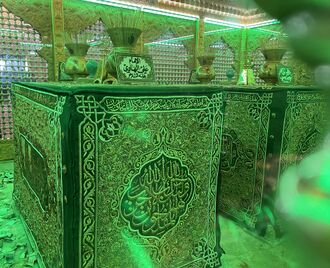Main Page

Maryam bt. 'Imrān, or Mary (a) was the mother of Jesus (a), whose pregnancy occurred miraculously. The story of her life, from her birth to the birth of her son, Jesus (a), is narrated in Qur'an 19 of the Qur'an. In Shiite and Sunni hadiths, Maryam (a) is considered one of the "four superior women" in the Heaven along with Fatima al-Zahra (a), Khadija bt. Khuwaylid (a), and Asiya (a).
There is no mention of Maryam's (a) life in the Gospel, but other Christian sources, as well as the Qur'an and Islamic hadiths, have provided information about Maryam's (a) life. In Christian sources, her father's name is said to be "Joachim," and in the Qur'an and Islamic hadiths, he is mentioned as "'Imran." According to a hadith from Imam al-Baqir (a), 'Imran was an Israelite prophet. According to Ibn Ishaq's report, his lineage goes back to David (a) the prophet. 'Imran died before the birth of Maryam (a). Her mother is said to be Anne, which is transformed in Arabic as "Hanna" (Arabic: حنة), the daughter of Faqud.
In Christian texts, Maryam (a) has been referred to by numerous titles, such as the New Eve, Virgin Mary, Mother of God, the Intercessor, Mother of Divine Providence, the Seat of Wisdom, the Spiritual Vessel, the Mystic Rose, the Ark of the Covenant, the Queen of Angels, and Our Lady of Sorrows. She is also referred to in Islamic texts as "al-'Adhra'" (Chaste) and "al-Batul" which means she was detached from men or because she did not have menstruation.
Maryam (a) is said to be born twenty years before the birth of Jesus (a). However, there is no information about where she was born. According to sources, Hanna, the mother of Maryam (a), was sterile. She could not give birth to any children until the age of thirty. She prayed to God and asked Him to give her a child. Her prayer was answered, and she became pregnant with Maryam (a). Hanna vowed to God that her child will serve Bayt al-Maqdis. Verses thirty-five to thirty-seven of Qur'an 3 refer to Hanna's vow and its acceptance by God.....
Other featured articles: Miqdad b. Amr – Muhammad b. Ya'qub al-Kulayni – Marja'
- ... Elizabeth, the mother of Prophet Yahya (a), was Mary's aunt?
- ... the house in which Prophet Ya'qub (a) mourned the separation from his son, Yusuf (a), was also called Bayt al-Ahzan?
- ... the responsibility for the service and guardianship of the Kaaba, known as the Sedanat, was held by the Banu Shaiba tribe before Islam, and after the conquest of Mecca, the Prophet (s) entrusted them with the keys, a responsibility they have held ever since?
- Month of Rajab «The seventh month of the Islamic calendar, regarded as one of the sacred months with special devotional practices.»
- Laylat al-Ragha'ib «The first Thursday night of Rajab which has especial rituals.»
- Birth of Imam Ali (a) Inside the Ka'ba «is regarded as his exclusive virtue and is widely reported in Shi'a and Sunni sources.»
- Imam Muhammad al-Baqir (a) «The fifth Imam of the Shi'a, known as Bāqir al-ʿUlūm, born on 1 Rajab, renowned for his profound knowledge and role in the development of Shi'a teachings.»
- Mi'raj «The nightly journey of the Holy Prophet (s) from Mecca to al-Aqsa Mosque and from there to the skies.»
- Change of the Qibla «In Rajab, 2 AH/ 624 CE, the qibla of Muslims was changed from al-Aqsa Mosque to the Ka'ba in Mecca.»
- Bi'tha «Bi'tha marks the beginning of Prophet Muhammad’s (s) mission, which began on Rajab 27, 13 lunar years before Hijra/June 25, 610 CE, with the first revelation in the Hira' cave near Mecca.»
- Al-'Umra al-Rajabiyya «A type of al-'umra al-mufrada performed in Rajab, considered especially virtuous, with rewards close to those of Hajj.»
- Historical Anniversaries of Rajab «Rajab is a sacred month in Islam, known for important events and special acts of worship.»
- Ruh Allah (epithet)
- Kufr
- Guardianship of the Jurist
- Talutiyya Sermon
- Aqila Bani Hashim (epithet)
- Kafir
- Kafir al-muhadin
- Al-I'tisam Verse
- Abdulaziz Sachedina
- Israel (epithet)
- Alimatun ghayru mu'allama
- Al‑Jar thumma al‑Dar
- Zahra (epithet)
- Sariyya of Imam Ali (a) in Yemen
- Marriage of the Prophet (s) with Zaynab bt. Jahsh
- Insha Allah
- Demise of the Prophet (s)
- Hadith of I and the Hour
- Laylat al-Harir
- Sermon of Laylat al-Harir
Today Wednesday, 17 December, 2025 / 26 Jumada II, 1447
- 1273 CE – Demise of 'Abd al-Rahim Kalibari (Jumada II 5, 672 AH)
- 1915 CE – Demise of 'Abd al-Rahim Kalibari (Safar 9, 1334 AH)
- 1924 CE – Demise of Mirza Baha' al-Din Fadil Nuri, a Shi'a scholar and poet. (Jumada I 20, 1343 AH)
- 1989 CE – Demise of Sayyid Isma'il Asfiya'i, a Shi'a scholar and the father of Sayyid Abd Allah Fatimi Niya. (Jumada I 18, 1410 AH)
- 1992 CE – Demise of Sayyid Muhammad Hasan Mirjahani (Jumada II 21, 1413 AH)
- 2001 CE – Demise of Sayyid Muhammad Shirazi (Shawwal 1, 1422 AH)
- 254 AH - Martyrdom of Imam al-Hadi (a) according to some account (June 22, 868 CE)



